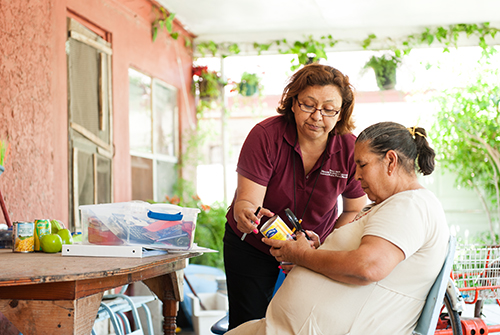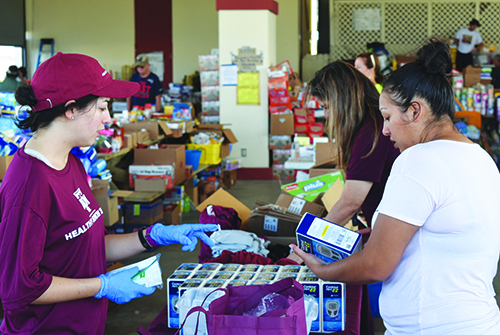Daniel Garcia didn’t fully understand the potential ramifications of Type 2 diabetes when he was first diagnosed in 2005. The Corpus Christi native received varying recommendations from different doctors and was prescribed a slew of medications that didn’t work for him. Confused about what he should do, Garcia took the easiest path: He continued to eat his favorite foods and did not exercise regularly.
These unhealthy lifestyle choices caught up with him almost a decade later when he moved to Austin as a young adult. Uninsured and unable to afford his medications, Garcia was hospitalized when his infected foot became swollen to the point where he couldn’t walk. A few days later, Garcia realized that there was a problem with his vision when he was unable to see clearly enough to watch television shows.
Now Garcia, who is legally blind, must relearn how to navigate his life, live with his diabetes and avoid other life-threatening problems. Fortunately, he has Healthy Texas, a unique partnership between the Texas A&M Health Science Center and AgriLife Extension Service, to guide him in making healthy choices. “I’ve learned that it’s important to educate myself in order to better my life,” the 36-year-old said. “I don’t want to die early.” Additionally, Garcia’s entire family has participated in the program so they can adopt a healthier lifestyle and support each other in self-management that will help prevent diabetes or reduce the chances for diabetes-related effects such as blindness.
 The Healthy Texas Initiative, a unique partnership between Texas A&M’s Health Science Center and AgriLife Extension Service, is helping rural and underserved Texans be more proactive in making healthy choices through educational programmaing and outreach. Here, a Healthy Texas representative reviews a nutrition facts label with a Texas resident.
The Healthy Texas Initiative, a unique partnership between Texas A&M’s Health Science Center and AgriLife Extension Service, is helping rural and underserved Texans be more proactive in making healthy choices through educational programmaing and outreach. Here, a Healthy Texas representative reviews a nutrition facts label with a Texas resident.
Major Gaps in Care in the Lone Star State
As the nation’s second most populous state, Texas is large and diverse. However, much of its medical care is concentrated in major urban areas, and there are also notable health disparities in areas such as South Texas. A 2015 report found that 57 percent of the state’s practicing physicians work in the five largest urban counties—Dallas, Tarrant, Harris, Travis and Bexar—even though these counties are home to less than half of the state’s total population.
In comparison, many smaller urban areas such as Corpus Christi and McAllen as well as the many more rural areas in South Texas are under-resourced due to a critical shortage of primary care providers and the closure of rural hospitals. Currently, 35 counties do not have a physician practicing in their area, while 80 counties have five or fewer physicians. Additionally, 147 counties do not have an obstetrics and gynecology physician, 158 counties do not have a general surgeon and 185 counties do not have a psychiatrist.
Expanding Health Care across Texas
Recognizing the looming public health crisis, Texas A&M University leaders developed the Healthy South Texas initiative in 2015 to provide individuals, families and health care professionals in 27 South Texas counties with the knowledge and the resources to take control of their health. This effort was funded through an initial $10 million investment from the 84th Texas Legislature.
Because of the resounding initial success of the pilot program in South Texas, this effort is steadily expanding across Texas as the Healthy Texas initiative, and the state has provided additional funding in the current biennium. “Creating sustainable change that turns preventable diseases into history is our goal,” said Carrie L. Byington, MD, vice chancellor for health services at The Texas A&M University System, senior vice president of the Texas A&M Health Science Center and dean of the College of Medicine. “When the Healthy South Texas project launched two years ago, it seemed like an ambitious goal. Today, we see change happening in so many communities that has resulted in healthier lives.”
The interdisciplinary effort innovatively taps into The Texas A&M University System’s assets across the state, including: the Texas A&M Coastal Bend Health Education Center (regional headquarters of Healthy South Texas); Texas A&M College of Medicine; Texas A&M Irma Lerma Rangel College of Pharmacy; Texas A&M School of Public Health; Texas A&M College of Nursing; Texas A&M Institute of Biosciences and Technology; Texas A&M College of Architecture’s Colonias Program; Texas A&M University-Corpus Christi; Texas A&M International University in Laredo; and Texas A&M AgriLife Extension Service.
Although also working in under-resourced metropolitan areas, the Healthy Texas initiative supports the Health Science Center’s priority to improve rural population health. The lack of access to quality health care is especially dangerous for rural Texans. In general, individuals living in these areas are older, poorer and less educated then their urban counterparts. Nearly one-fifth of these individuals live below the poverty line and have difficulty affording their medications. A similar percentage do not have high school diplomas and many do not understand the importance of taking a proactive approach to protecting their health. In some far-flung counties, individuals must travel more than 30 miles to see a doctor. The lack of resources and readily accessible health care means that rural residents have a higher risk of dying from chronic diseases, which require greater medical maintenance and access to reliable health care, than their urban counterparts. In fact, rural Texans have a 25 percent higher death rate from ischemic heart disease and a 53 percent higher death rate from chronic obstructive pulmonary disease.
 The Healthy Texas initiative offers research-based programming focused on lifestyle behaviors, health and wellness as well as both public and professional education. One of its programs, Well Baby, focuses on infant and maternal care.
The Healthy Texas initiative offers research-based programming focused on lifestyle behaviors, health and wellness as well as both public and professional education. One of its programs, Well Baby, focuses on infant and maternal care.
Putting the Pieces Together
Healthy South Texas encourages Texans to take personal responsibility for their own health to reduce the burden of costly, preventable diseases as well as preparing health care providers and others to be more responsive to the health needs of residents in South Texas. Therefore, the initiative offers research-based programming focused on lifestyle behaviors, health and wellness as well as both public and professional education. These programs are designed to engage families, enhance education, promote behavior change and improve the quality of medical care and health outcomes. Examples of programmatic activities include:
- Diabetes Control Program – This program provides education and support to individuals who are diagnosed with or at risk for Type 2 diabetes. This outreach is essential for preventing or delaying the risk of heart attack, stroke, kidney failure, amputation and death.
- Asthma Control Program – This effort is designed to offer increased awareness and education for South Texans who have a high rate of poor asthma outcomes due to socioeconomic, environmental and behavioral causes.
- Infectious Disease Education – This program, which focuses on educating health care professionals and the public, was created in response to increasing concerns about mosquito-borne diseases, such as Zika, but also addresses control of other infectious diseases prevalent at the border.
- Nutrition Education – Families have access to quick, healthy and cost-effective recipes as well as videos that feature best practices for food preparation and food safety.
- Walk Across Texas! – Teams of up to eight people are encouraged to take part in regular physical activity by challenging themselves to complete 832 miles—the distance from El Paso to Texarkana—in a two-month period. Engaging in regular physical activity can help prevent or manage numerous health issues, including heart disease, Type 2 diabetes, hypertension, osteoporosis and certain cancers.
- Well Baby – Evidenced-based health education is offered to improve infant and maternal care, and family members of all ages are encouraged to work together to reach the goal of healthy families and healthy communities.
- Youth Outreach – School-aged youth are encouraged to develop healthy habits that they can maintain throughout their lives.
- Wellness Resources and Outreach – This program includes health fairs and screening events as well as access to affordable medications for uninsured and underinsured individuals.
- Engaging Volunteers – Trained volunteers through AgriLife Extension facilitate educational programming in their communities, thus extending the initiative’s reach.
- Public Health Education and Training – Healthy South Texas offers needs-based training to strengthen public health competencies for health professionals, community health workers and extension agents.
Healthy Texas is constantly evolving as the initiative’s staff identifies emerging health challenges and then creates targeted programming toward those issues, which have included Zika, the opioid crisis and disaster response. “Healthy Texas is addressing the specific issues and concerns of our different communities,” said Director of Healthy Texas for the Health Science Center Marcia Ory, Ph.D., Regents and Distinguished Professor in the School of Public Health, who also serves as the Health Science Center’s associate vice president for strategic partnerships. “We’re not coming out and telling individuals what they have to do. We’re listening to them to get a sense of the health issues and outbreaks they are facing and then addressing those issues with our best evidence-based practices and programs.”
Healthy Texas also reaches out to area hospitals and health care professionals as well as key community organizations and businesses. “We’re trying to leverage community partnerships, which provide funding or in-kind support such as use of an office space or referrals,” said Starr Flores, who serves as the regional director of Healthy Texas and director of the Coastal Bend Health Education Center in Corpus Christi.
 A focus of the Healthy Texas initiative is reducing preventable diseases such as diabetes and asthma through educational outreach. Here, a Healthy Texas representative introduces glucometers to Texas residents. For people with diabetes, glucometers measure accurate and efficient readings of blood glucose levels.
A focus of the Healthy Texas initiative is reducing preventable diseases such as diabetes and asthma through educational outreach. Here, a Healthy Texas representative introduces glucometers to Texas residents. For people with diabetes, glucometers measure accurate and efficient readings of blood glucose levels.
Making a Difference in Dollars and (Good) Sense
Overall, the Healthy Texas initiative recorded more than 1.2 million total contacts of community residents and health care professionals from September 2015 through June 2018. More than 680,000 individuals have taken part in nutrition education while nearly 58,000 high school students and youth have learned about health and environmental-related topics since 2015. Over that same time frame, the asthma control program served more than 42,000 participants and the diabetes control program worked with more than 60,000 individuals. The initiative’s wellness resource and outreach engaged 250,000 individuals from 2015 to 2018.
The initiative has also proven to be highly cost-effective. Healthy South Texas already has resulted in more than $52 million annual cumulative savings due to disease self-management programs and medication assistance. Additionally, initiative leaders project over $100 million in potential lifetime savings (including prevented sick days from work due to related illnesses and medical costs) through participation in the AgriLife’s Walk Across Texas program. Improvement in participants’ health status also has the potential to result in substantial annual Medicaid savings and increased annual state revenue due to productivity gains.
Individuals Taking Ownership of Their Health
Kleberg County offers an impressive example of Healthy South Texas' power. As part of his analysis of the county’s health insurance program, County Judge Rudy Madrid found that many county employees and their families had preventable diseases and were taking expensive medications.
Madrid, who has a background as an emergency room trauma nurse, understood the ramifications of this analysis and started searching for options. “Wellness is a very key component to not only well-being but also preventative medicine,” Madrid said. “It helps us provide better health care to our employees and their beneficiaries at a more affordable cost to the county.”
He soon met with Healthy South Texas representatives and, after gaining the support of the county commissioners, began offering free programs in the courthouse to county employees. The commissioners approved giving incentives and time off from the workday so that county employees could attend classes and health fairs. Thus far, a majority of the county’s 300 employees have taken part in these programs, and the county has seen more than $2 million in savings on health care costs.
Because of this rousing success, county officials have invited citizens to participate. Signage promoting the free Healthy South Texas programs is visible on the courthouse grounds, and Madrid has teamed up with local media to promote the offerings. He is also opening the program to surrounding small ranch communities, including Alice and Falfurrias, which are located outside the county.
The judge sees Healthy South Texas as a way for area residents to prioritize their own health. “I tell people every day that we may not be able to fix our state- or federal-level health care, but we can take control of it in our own community and hometown,” Madrid said. “Through this program, we can have ownership of our own health. Healthy South Texas is working and it’s been a blessed program.”
To support the Healthy Texas initiative, contact Kirk Joseph '84 (below).